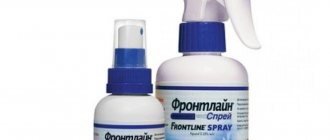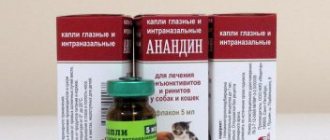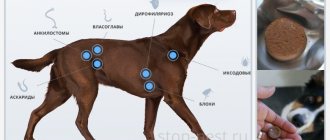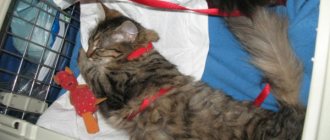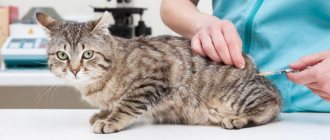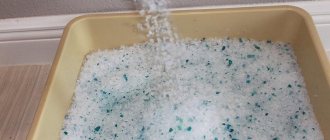Drops against ear mites for cats allow you to quickly destroy parasites. Often, cat owners who let their pets go for walks notice strange behavior in their animals: they shake their heads sharply and turn them to the side. Ear mites are common parasites that can also be found in domestic cats. A symptom of their appearance can also be loss of appetite.
What is an ear mite
Ear mites are microscopic ectoparasites. Adult individuals have a body length of 0.3-0.6 mm, so it is impossible to examine them without a microscope. They live in your pet's ear. At first, mites infect its outer part (outer ear), but gradually penetrate deeper and deeper.
The parasite has a claw-shaped mouthparts with which it pierces the skin. The parasite feeds on lymph and tissue fluid protruding to the surface.
Otodectosis can be recognized by the following signs:
- a cloying and unpleasant odor appears from one or both ears;
- a brown and loose coating appears inside the ear, under which ulcers and wounds form;
- the cat tilts its head towards the sore ear and scratches it;
- If an animal is severely infested with ticks, its hearing may deteriorate.
Without treatment, the disease progresses. The tick penetrates deeper into the animal's ear, infects its inner part, and then inflammation of the meninges occurs. In this case, the pet’s temperature rises, and seizures similar to epileptic seizures may begin.
Behavior of a cat when sick
When cats have ear mites, an attentive owner can notice this by the pet’s behavior. The animal often begins to shake its head and scratch its sore ear with its paw. If you look into the auricle, you will notice some discharge there at the initial stage of the disease. They appear from areas of the ear injured by tick bites.
Over time, this discharge dries out and turns into unpleasant dark brown scabs. If you touch your pet’s ear at such moments, he will shake his ears and meow pitifully. If there are a lot of these crusts, they will close the ear canal. And if treatment for the tick is not started in time, the eardrum may rupture and the inflammatory process can easily penetrate the brain.
This behavior of cats is due to the fact that when an animal is infected with mites, it experiences severe itching in the ear. Trying to get rid of this unpleasant sensation, they shake their heads, scratch their ears and tear the skin bitten by parasites until it bleeds. With complications, the cat may constantly walk with its head tilted and the sore ear down. In particularly advanced cases, when the meninges are damaged, the disease can lead to the death of the animal. To prevent this, the owner should show the pet to a specialist when the first symptoms of the disease appear.
Review of popular drugs for ear mites
Drops intended to kill ear parasites are divided into two types: some are instilled into the ears of cats, and others are applied to the pet’s withers.
The first drugs include:
- Bars (dimpylate and diazinon). This drug is bottled in glass bottles of 10 and 5 ml, or plastic bottles (30, 20, 15, 10 and 5 ml). For cats, the medicine is instilled into both ears, 2-3 drops. The course of treatment is two treatments with a break of 7 days.
- Surolan (prednisolone, polymyxin and miconazole). The drug has the form of a thick transparent suspension. Available in plastic bottles of 15 or 30 ml. Surolan effectively fights not only ear parasites, but also other diseases caused by fungi and bacteria (otitis media, dermatitis, etc.). The suspension is instilled into each ear, 3-4 drops, for 2 weeks.
- Oricin (ivermectin). The drug goes on sale in plastic bottles containing 25 ml of solution. Each bottle has a convenient dropper spout. For mild infection, treatment lasts 3-4 days. If the damage is severe, the course is extended to 7 days. 2 drops are dripped into each ear of the pet.
- Amitrazine (amitraz). An oily, yellow medicine with a pungent odor. It goes on sale in white plastic bottles of 20, 15 and 10 ml. 2-3 drops of medicine are instilled into the cat's ears. The course of treatment is 3-6 treatments with an interval of 3 days.
- Otoferonol. Available in three varieties: Plus (cycloferon and deltamethrin), Gold (cycloferon, deltamethrin and propolis extract) and Premium (permethrin). Dosage for cats: 2-3 drops in each ear. The course of treatment consists of two treatments, the interval between them is 7 days.
- Aurican (tetracaine, diazinon, prednisolone and hexamidine). Drops are poured into 20 ml bottles. The treatment regimen is as follows: the first 7 days - daily treatment with 4-5 drops in each ear, then treatment is carried out twice a week for 30 days.
Names and descriptions of drugs that are applied to the withers:
- Stronghold (selamectin). The medicine is packaged in small sealed pipettes. For cats, the dosage of selamectin is 45 mg (0.75 ml pipettes). Stronghold is applied to the pet’s withers once.
- Advocate (imidacloprid and moxidectin). The drops are sold in sealed pipettes. For cats, two dosages are available: for pets from 1.5 to 4 kg, and for large animals from 4 to 8 kg.
REFERENCE! You can fight ear mites not only with drops. Pet stores offer ointments, injection solutions and sprays that help rid your pet of parasites.
Criteria for choosing ear drops for cats
Otodectosis is a rather unpleasant disease for animals that causes discomfort. Anti-tick drops for cats are rightfully considered the most effective treatment method.
Among the wide list of drugs provided by the pharmacological market, it is quite difficult to choose an effective remedy. To make the right choice, you need to pay attention to several characteristics of ear mite drops:
- Mechanism of action. Exactly how the ticks will be affected depends on the main active ingredient in the drops. Some cause paralysis and death of mites, others stop the development of eggs and larvae hatching from them, thereby preventing the scenario where ear mites in cats may appear again.
- Contraindications. If the disease is in an advanced stage, there are open wounds on the ears or the eardrum has been damaged, treatment with drops is impossible. You also need to remember that pregnant and lactating females need delicate care, which means milder medications.
If necessary, you can first treat diseases that interfere with the use of drops, and only then deal with ticks.
Rules for the use of drugs
Treating a cat for ear parasites requires preliminary preparation. Before the procedure, it is necessary to heat the medicine to a temperature of 25-27 degrees. You should also prepare equipment: cotton pads, bandages or gauze, a solution for cleaning the inside of the ear.
The procedure is carried out as follows:
- The cat is calmed and restrained well. To do this, you can use a durable bag, carrier or thick blanket.
- The cat's ears need to be cleaned of brown deposits. To do this, a special lotion or saline solution is instilled into each ear, the auricle is folded in half and gently massaged. After this, the soaked plaque is removed with a clean cotton pad.
- The amount of the drug indicated in the instructions is instilled into each ear of the cat.
- After applying the drops, the base of the ear is folded and gently massaged so that the medicine is evenly distributed over the surface.
- After treatment, the animal is released. After this, the cat actively shakes its head, and excess drug is removed from the ear.
IMPORTANT! Many cats behave very aggressively during ear treatment, so it is necessary to securely restrain the pet.
How to use drops
If you suspect the presence of ticks, your cat should be examined by a veterinarian. Using an otoscope, he will examine the animal's ear canal to check for parasites. Samples of discharge from the diseased ear are also taken and examined under a microscope, examining the presence of live mites and their eggs. At the same time, the veterinarian must make sure that the eardrum is not broken, otherwise the ear drops will not be able to get inside.
Before using ear drops for cats, the ear of an adult animal or kitten must be thoroughly and very carefully cleaned. The pet should be wrapped in a towel and held tightly so that it does not scratch you. It is convenient to clean with an ear stick or a cotton swab. If you have dry scabs, you should first drop some medicine into your ears to make them softer. At the same time, cats are given the opportunity to shake their heads so that the drug and all contaminants are shaken out of the ear.
After removing all contaminants, you can proceed directly to treatment. First, be sure to read the instructions that come with the drug in order to know how many drops to give to cats and what side effects there may be. If necessary, you can drip these drops onto the withers. Medicines against ticks can also be used to prevent the disease.
During the burial procedure, the animal must be held tightly so that it cannot move. His head should be tilted to one side, with his ear up. After instillation, the drops must be lightly rubbed so that they do not leak out. They must be instilled in both ears, even if the parasites have settled in only one of them. If after several daily procedures there is no relief, you should contact the veterinarian again.
To prevent your pet from becoming infected with ticks, you can periodically use ear drops as a preventive measure, as recommended by your veterinarian. You should not allow your pets to interact with sick animals. It is necessary to visit the veterinary clinic periodically to ensure the health of your pets.
Contraindications, side effects and precautions
Most anti-ear mite medications have an age limit. Small kittens under 2 months of age should not be treated. It is also not recommended to treat weakened animals with drops.
Possible side effects include the development of an allergic reaction. It is rarely observed, and in this case the pet should be taken to a veterinarian.
Before treating your cat with drops, you must put on medical latex gloves. If the medicine gets on the skin, wash it well with soapy water. Drop containers are disposed of with household waste.
When is it prescribed?
The indication for their use is otitis media of various etiologies:
- Bacterial. Most often caused by gram-negative bacteria. Otitis in this case is often purulent in nature, the disease is accompanied by high fever and intoxication syndrome.
- Fungal. Caused by pathogenic fungi, it leads to hearing impairment, inflammation, and swelling.
- Otodectosis. Another name is ear scabies. The causative agent is ear mites.
Drops are used to eliminate the cause of otitis media, as well as to reduce inflammation, swelling and pain.
Otomycosis: when fungi grow in the ears
When mentioning fungal diseases in humans, most of us will probably only remember nail fungus or thrush. But it turns out that there are also mushrooms that grow in the ears and cause a lot of trouble to a person. The pathological process caused by fungi in the ears is called otomycosis.
What is fungal otitis and how does it happen?
Otomycosis is a disease of various parts of the ear, which is caused by certain types of mold and yeast-like fungi. Most often, the causative agent of the pathological process is fungi from the genus Aspergillus
and
Candida
.
Otomycosis is a kind of collective concept that indicates the fungal nature of ear pathology. The specific name of the disease depends on which part of the ear is affected: if the auricle and skin of the external auditory canal are involved in the pathological process, this is fungal external otitis; if the process spreads to the eardrum, they speak of fungal myringitis; if the tympanic cavity (middle ear) is affected, then it is fungal otitis media.
What causes otomycosis?
As a rule, those fungi that cause otomycosis are classified as opportunistic, i.e. they cause the disease only if there are predisposing factors. Factors that increase the risk of otomycosis include:
- injuries to the skin of the auricle and auditory tube (most often due to improper hygiene of the outer ear, the use of cotton swabs, as well as allergic diseases accompanied by itching and scratching), which increase the risk of the fungus penetrating the skin and opening the gates of infection;
- existing inflammatory diseases of the ear, since local immunity is significantly reduced;
- fungal infection of other localizations, for example, fungus of the nail plate, foot, thrush, etc. Most often, a fungal infection manifests itself against the background of decreased immunity and changes in the composition of the skin microflora. Disturbances occur throughout the body, so if a fungal infection appears in one place, there is a chance that it will manifest itself somewhere else;
- diabetes mellitus - sugar, the content of which in earwax increases significantly during this disease, is a good nutrient medium for fungi and promotes their growth;
- concomitant chronic diseases that lead to a decrease in the body’s overall resistance;
- taking antibiotics, glucocorticosteroids, cytostatics - long-term and irrational use of these drugs leads to changes in the normal composition of the skin microflora and the development of pathogenic microorganisms.
Symptoms of the disease
Most often, otomycosis affects the ear on only one side. Manifestations of the disease depend on which part of the ear is affected. The common feature is the gradual onset of the disease and the progression of symptoms as the mycelium of the fungus grows into the thickness of the skin.
For external otomycosis
The disease begins with swelling of the external auditory canal, gradually accompanied by itching, pain, and a feeling of ear congestion. Later, discharge from the external auditory canal appears. The nature of the discharge depends on the type of fungus: with candidiasis, it is a liquid, cheesy discharge, often white or yellowish in color; with aspergillosis, it is a thick discharge, ranging in color from green to gray-black.
Features of application
Before using the drops, it is necessary to clean the ear canal of pus, scabs and crusts. To do this, you can use cotton swabs soaked in a warm solution. After cleaning the passage, you can proceed directly to instilling the solution.
Something else interesting: Cat Bayun for cats - instructions for use
The drug is instilled into the external auditory canal 2-3 times a day (more often on the first day of treatment). The ears are then gently massaged for better penetration. Excess should be wiped off with a cotton swab. The duration of the course of treatment is 3–7 days, depending on the condition of the pet.
Ear drops can have either a single or combined effect. All agents are divided depending on what infectious agents they act on and what effect they have. Let's take a closer look at the most common means.
Leopard
It is a drug of combined action. The main substance is dimpylate. It is active against ticks and insects, including fighting the causative agent of otodectosis. Additional components that are part of the solution have an anti-inflammatory effect and also reduce tissue swelling.
The main indication for use of the drug "Bars" is ear scabies (otodectosis).
Otoferonol
A drug with pronounced anti-inflammatory activity. The main active ingredient is cycloferon. Reduces signs of inflammation, relieves swelling and relieves pain in cats.
There are several types of the drug:
- "Otoferonol Gold" also affects ticks. This is explained by the fact that the drug contains another basic component – deltamethrin. It blocks the transmission of nerve impulses from nerve tissue to muscles, thus leading to paralysis and death of the insect.
- Otoferonol Premium, thanks to its additional composition (in the form of permethrin), also affects ticks, leading to their death. In addition, the drug contains dexamethasone, a glucocorticoid that provides a stronger reduction in swelling.
Otidez
"Otidez" is a combination drug and has a wide range of applications. This is due to the following composition:
- gentamicin is an antibiotic that has a bactericidal effect;
- permethrin – fights ticks, leading to their death;
- dexamethasone is a glucocorticoid that reduces inflammation and swelling;
- terbinafine hydrochloride is an antimycotic substance aimed at destroying pathogenic fungi;
- Jubenzocaine is a local anesthetic that helps relieve pain.
Otibiovin
"Otibiovin" is a drug that has an antimicrobial effect and also reduces inflammation and pain. Its complex action is due to the following composition:
- gentamicin – destroys pathogenic microorganisms, used to treat bacterial otitis;
- triamcinolone glucocorticoid - a corticosteroid with a pronounced anti-inflammatory effect, reduces itching;
- salicylic acid is an antiseptic and soothing component.
Something else interesting: Rules for choosing and using eye drops for cats
The main indication for use is bacterial otitis media, which is accompanied by swelling, pain and inflammation.
Anandin
Anadin is used to treat bacterial otitis. The basic active ingredient is gramicidin C, which is a local antibiotic. Has a bactericidal effect on gram-positive and gram-negative microorganisms. Additional components that are included in the drops help reduce the inflammatory reaction and also accelerate regeneration processes.
After using Anadin drops, the cat’s inflammation and pain decrease, the drug acts directly on the cause of otitis media.
Surolan
"Surolan" is a complex remedy that is used to treat otitis media of a bacterial or parasitic nature, as well as for otodectosis. The effects that Surolan has are due to the substances that are included in its composition:
- miconazole is a substance that is aimed at destroying pathogenic fungi;
- polymyxin B is an antibiotic that affects gram-negative microorganisms;
- prednisolone is a glucocorticoid that reduces the manifestation of the inflammatory reaction, swelling, pain and itching.
Tsipam
"Tsipam" is a combination drug whose main effect is aimed at ticks. It contains 2 active ingredients:
- cypermethrin;
- amitraz.
The action of each of them is to block the conduction of nerve impulses, which leads to muscle paralysis and death of the tick. The main indication for the use of Tsipam drops is ear mites.
Contraindications
Like any other medications, ear drops have a number of contraindications:
- Hypersensitivity to the components of the drug (including a history of allergic reactions).
- Suspicion of perforation of the eardrum.
- Pregnancy and lactation (use of the drug during this period is permitted only after consultation with a veterinarian).
After using the drops, you must carefully monitor the cat's condition; if allergic manifestations or other side effects occur, you must seek medical help.





